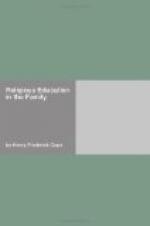The last type brings us to the Hebrew conception of family life. It developed toward the Christian ideal. At first, polygamy was permitted; woman was the chattel of man and excluded from any part in the religious rites. But it included the ideal of monogamy in its tradition of the origin of the world, it denounced and punished adultery (Deut. 22: 22), and it gave especial attention to the training of the offspring. “And these words, which I command thee this day, shall be in thine heart; and thou shalt teach them diligently unto thy children, and shalt talk of them when thou sittest in thy house, and when thou walkest by the way, and when thou liest down, and when thou risest up ... and thou shalt write them upon the door-posts of thy house and upon thy gates” (Deut. 6: 6, 7, 9).
Much later, the messianic hope, the belief that in some Jewish family there should be born one divinely commissioned and endowed to liberate Israel and to give the Jews world-sovereignty, operated to elevate the conception of motherhood and, through that, of the family. It made marriage desirable and children a blessing; it rendered motherhood sacred. It tended to center national hopes and religious ideals about the family.[9]
There are a few glimpses of ideal family life in the Old Testament. They are all summed up in the eloquent tribute to motherhood in the words of King Lemuel in the last chapter of the Book of Proverbs. It must be remembered, however, that such ideals did not belong to the Jews alone, that Plutarch shows many pictures of maternal fidelity and wifely devotion, that Greek and Roman history have their Cornelia, Iphigenia, and Mallonia.[10]
The Jews are an excellent example of the power of the family life to maintain distinct characteristics and to secure marked development. Practically throughout all the Christian era they have been a people without a land, a constitution, or a government, and yet never without race consciousness, national unity, and separateness. Their unity has continued in spite of dispersion, persecution, and losses; they have remained a race in the face of political storms that have swept other peoples away. Their unity has continued about two great centers, the customs of religion and the life of the family.
The results of Jewish respect for family life can also be seen in the health of their own children. In 1910, for instance, among poor Jews in Manchester the mortality of infants under one year of age was found to be 118 per thousand; among poor Gentiles, 300 per thousand; and comparisons made some six years ago between Jewish and Gentile children in schools in the poorer parts of Manchester and Leeds (England) have shown that the Jewish children are uniformly taller, they weigh more, and their bones and teeth are superior.[11]




